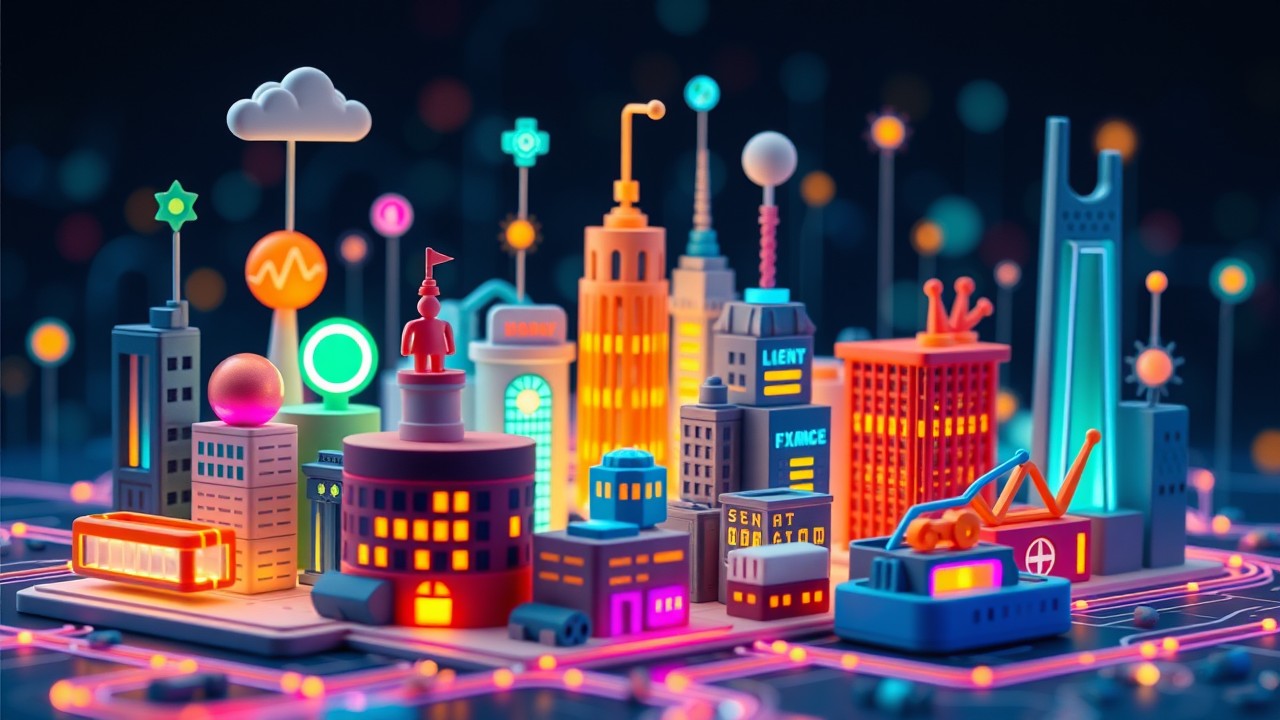The AI and Big Data Revolution: Reshaping Healthcare, Finance, and Manufacturing 🚀
 Daniel Parente
Daniel Parente

Imagine a world where machines predict diseases before symptoms appear, banks detect fraud in milliseconds, and factories produce custom goods at lightning speed. This isn’t science fiction — it’s the near future, driven by artificial intelligence (AI) and big data analytics. These game-changing technologies are set to redefine industries like healthcare, finance, and manufacturing in ways we’re only beginning to grasp.
But why should we care? How will these changes affect our daily lives? Let’s dive in and explore the transformative power of AI and big data across these crucial sectors.
Article Key Takeaways:
AI and big data analytics are revolutionizing decision-making across industries
Personalized experiences and services will become the new standard
Ethical considerations and challenges must be addressed for successful implementation
The future of healthcare, finance, and manufacturing depends on embracing these technologies
Bridging the digital divide is crucial for equitable access to AI-driven benefits

Healthcare: From Reactive to Proactive
Healthcare is undergoing a major transformation, thanks to AI and big data. We’re moving from a reactive model of treating illnesses to a proactive approach focused on prevention and early intervention.
Early Detection and Diagnosis
AI algorithms can now spot diseases far earlier than human doctors, potentially saving countless lives. For instance, researchers at Massachusetts General Hospital and MIT developed an AI system that can detect lung cancer with 94% accuracy, significantly outperforming human radiologists who achieved only 65% accuracy.
This early detection capability extends to other conditions too. AI-powered tools are being used to:
Identify early signs of Alzheimer’s disease through speech pattern analysis
Detect diabetic retinopathy from eye scans
Predict heart disease risk based on ECG readings
Personalized Treatment Plans
Gone are the days of one-size-fits-all treatments. AI is ushering in an era of personalized medicine, tailoring treatment plans to individual patients based on their genetic makeup, lifestyle, and environmental factors.
IBM Watson for Oncology is a prime example of this approach. It analyzes a patient’s medical records, relevant medical literature, and clinical trials to recommend personalized cancer treatment options. In a study at the University of North Carolina, Watson recommended the same treatments as human experts in 99% of cases.
Streamlined Hospital Operations
AI isn’t just improving patient care — it’s also making hospitals run more efficiently. From optimizing staff schedules to managing inventory, AI is helping healthcare facilities operate smoother than ever.
For example, Johns Hopkins Hospital uses an AI-powered system called Capacity Command Center to manage patient flow. This system has reduced emergency room wait times by 25% and allowed the hospital to accept 60% more transfer patients from other hospitals.
Challenges in Healthcare AI
Despite these exciting advancements, the integration of AI in healthcare faces several challenges:
Data Privacy: With the increasing collection and analysis of personal health data, ensuring patient privacy is more critical than ever.
Ethical Concerns: As AI takes on more decision-making roles in healthcare, questions arise about accountability and the potential for bias in algorithms.
Integration with Existing Systems: Many healthcare facilities struggle to integrate AI technologies with their existing IT infrastructure.
Regulatory Hurdles: The fast pace of AI development often outstrips regulatory frameworks, creating uncertainly in implementation.

Finance: Money Matters Made Smarter
The financial sector is another area where AI and big data are making waves. From fraud detection to personalized financial advice, these technologies are reshaping how we manage and interact with money.
Fraud Detection and Prevention
AI excels at spotting patterns and anomalies, making it a powerful tool for fraud detection. Banks and financial institutions are using AI to analyze transactions in real-time, flagging suspicious activity before it results in significant losses.
For instance, Danske Bank implemented an AI-based fraud detection system that reduced false positives by 60% and detected 50% more fraud cases compared to their previous rule-based system.
Robo-Advisors and Personalized Investment
AI-powered robo-advisors are democratizing investment advice, making it accessible to a broader range of people. These systems use algorithms to create and manage investment portfolios based on an individual’s financial goals, risk tolerance, and market conditions.
Betterment, one of the leading robo-advisor platforms, manages over $22 billion in assets for more than 600,000 customers. Its AI-driven approach has shown to outperform traditional investment methods in many cases.
Risk Assessment and Credit Scoring
AI is revolutionizing how financial institutions assess risk and determine creditworthiness. By analyzing a wider range of data points, including social media activity and spending patterns, AI can provide a more nuanced and accurate picture of an individual’s financial health.
ZestFinance, for example, uses machine learning to help lenders make more accurate credit decisions. Their system has been shown to reduce loan losses by 20% while increasing approval rates by 15%.
Challenges in Finance AI
The integration of AI in finance isn’t without its hurdles:
Job Displacement: As AI takes over more tasks, there are concerns about job losses in the financial sector.
Algorithmic Bias: AI systems can perpetuate or even amplify existing biases in lending and investment decisions.
Regulatory Compliance: The use of AI in finance raises new regulatory questions, particularly around transparency and accountability.
Cybersecurity Risks: As financial systems become more reliant on AI, they may become more vulnerable to sophisticated cyber attacks.

Manufacturing: Factories of the Future
The manufacturing sector is undergoing its own AI-driven revolution, often referred to as Industry 4.0. From predictive maintenance to quality control, AI and big data are reshaping how goods are produced.
Predictive Maintenance
AI’s ability to analyze vast amounts of data from sensors and equipment is enabling predictive maintenance, reducing downtime and extending the lifespan of machinery.
For example, Siemens uses AI to predict failures in its gas turbines. By analyzing data from sensors, the system can predict potential issues up to two weeks in advance, allowing for proactive maintenance and avoiding costly breakdowns.
Quality Control and Defect Detection
AI-powered computer vision systems are revolutionizing quality control in manufacturing. These systems can inspect products at speeds and accuracy levels far beyond human capabilities.
BMW uses AI-based image recognition to inspect components during production. The system can detect the tiniest deviations from the standard, ensuring consistently high-quality products.
Supply Chain Optimization
AI is also transforming supply chain management, enabling more accurate demand forecasting and efficient inventory management.
Amazon uses machine learning algorithms to predict customer demand and optimize its massive supply chain. This AI-driven approach has helped Amazon reduce its inventory holdings by billions of dollars while improving delivery times.
Challenges in Manufacturing AI
The adoption of AI in manufacturing faces several obstacles:
High Initial Costs: Implementing AI systems often requires significant upfront investment, which can be a barrier for smaller manufacturers.
Skills Gap: There’s a shortage of workers with the skills to implement and manage AI systems in manufacturing settings.
Data Quality: AI systems are only as good as the data they’re trained on, and ensuring high-quality data can be challenging in manufacturing environments.
Integration with Legacy Systems: Many manufacturers struggle to integrate AI technologies with their existing equipment and processes.
The Big Picture: Connecting the Dots
As we’ve seen, AI and big data are set to transform healthcare, finance, and manufacturing in profound ways. But what does this mean for society as a whole?
Efficiency and Productivity Gains
Across all these sectors, AI and big data are driving significant improvements in efficiency and productivity. This could lead to lower costs for consumers, faster service delivery, and the ability to do more with less.
Personalization at Scale
From tailored medical treatments to personalized financial advice and custom manufacturing, AI is enabling a level of personalization that was previously impossible at scale.
Data-Driven Decision Making
In all these industries, gut feelings and intuition are being replaced by data-driven decision making. This has the potential to lead to more accurate and objective choices, though it also raises questions about the role of human judgment.
New Jobs and Skills
While AI may displace some jobs, it’s also creating new ones. There’s growing demand for data scientists, AI specialists, and professionals who can bridge the gap between AI systems and traditional business operations.

The Road Ahead: Challenges and Opportunities
As we navigate this AI-driven future, several challenges and opportunities lie ahead:
Ethical Considerations
As AI takes on more decision-making roles, we need to grapple with ethical questions about accountability, transparency, and fairness. Who’s responsible when an AI system makes a mistake? How do we ensure AI doesn’t perpetuate existing biases?
Privacy and Security
With the increasing collection and analysis of personal data, ensuring privacy and security is more crucial than ever. We need robust systems and regulations to protect sensitive information from misuse or breaches.
The Human Element
As we rush to embrace AI, we mustn’t forget the importance of human skills like creativity, empathy, and critical thinking. The most successful implementations of AI will likely be those that find the right balance between human and machine capabilities.
Regulatory Frameworks
Laws and regulations are struggling to keep pace with rapid technological advancements. We need flexible yet robust regulatory frameworks that can foster innovation while protecting consumers and ensuring fair competition.
Digital Divide
As AI and big data become more integral to various industries, we need to ensure equitable access to these technologies and their benefits. We must work to bridge the digital divide to prevent a world of AI “haves” and “have-nots.”
Further References & Infography
Big Data In 5 Minutes | What Is Big Data?| Big Data Analytics | Big Data Tutorial | Simplilearn
AI Is Dangerous, but Not for the Reasons You Think | Sasha Luccioni | TED
Transforming Healthcare Analytics with Automation and AI
Infography


Conclusion: Embracing the Future
AI and big data analytics are more than just buzzwords — they’re the building blocks of our future. They’re set to redefine industries like healthcare, finance, and manufacturing in ways that will touch all our lives.
The potential benefits are enormous: more effective healthcare, smarter financial decisions, and more efficient manufacturing. But realizing these benefits will require careful navigation of the challenges ahead.
As we move forward, it’s crucial that we shape the development and implementation of these technologies to ensure they serve humanity’s best interests. This means investing in education and training, developing ethical guidelines, and creating inclusive policies that ensure the benefits of AI are widely shared.
The future is knocking, and it’s powered by AI and big data. Are we ready to answer the door? 🚀
So stay tuned for updates on these futures. And if you found this glimpse beyond the bleeding edge compelling, hit those clap buttons to help spread the word!
If you want to read more interesting content don’t forget to check on my blog.
Subscribe to my newsletter
Read articles from Daniel Parente directly inside your inbox. Subscribe to the newsletter, and don't miss out.
Written by
